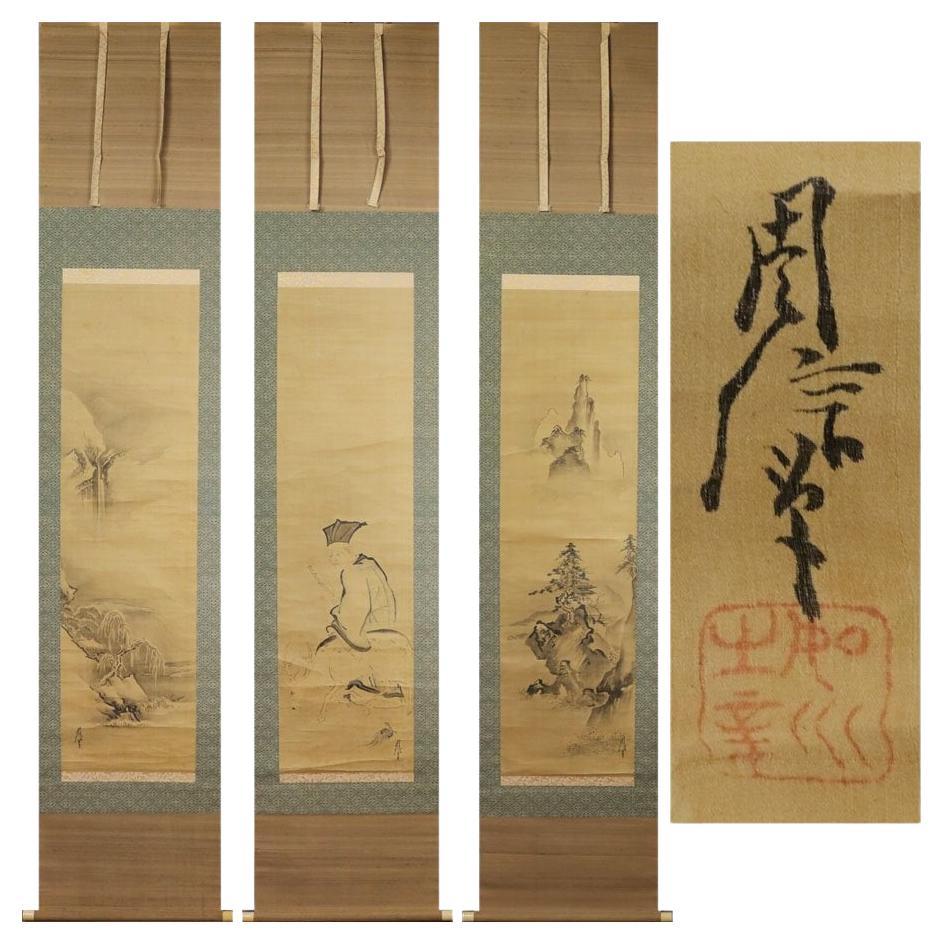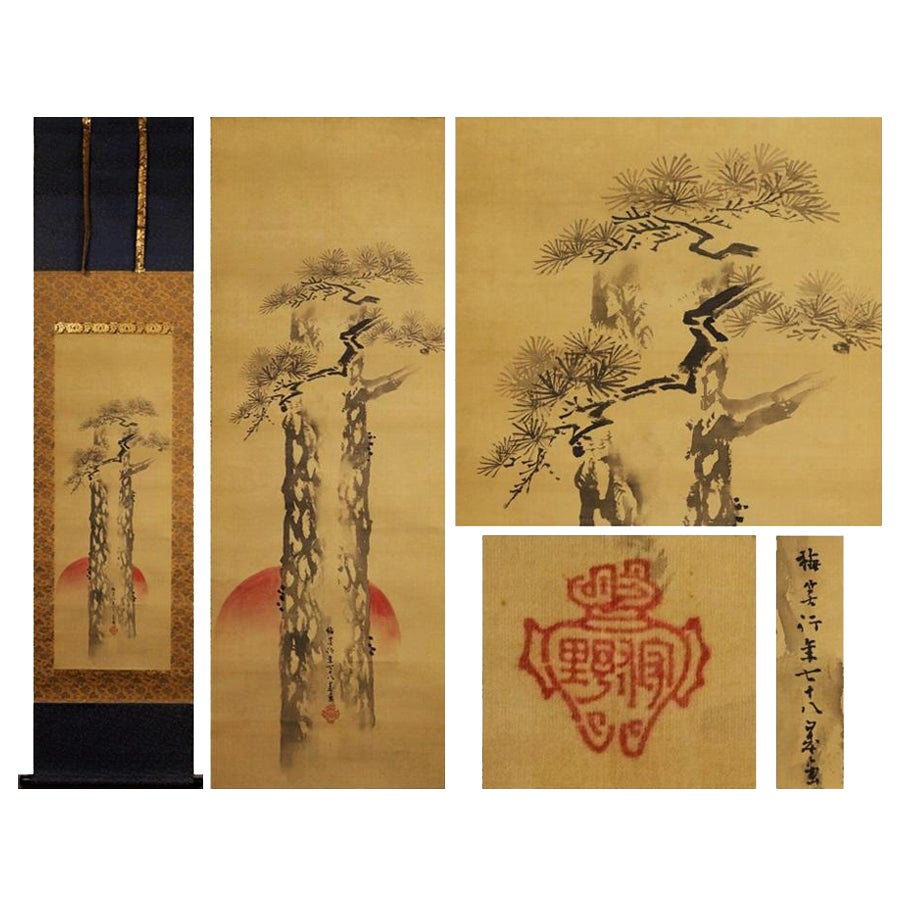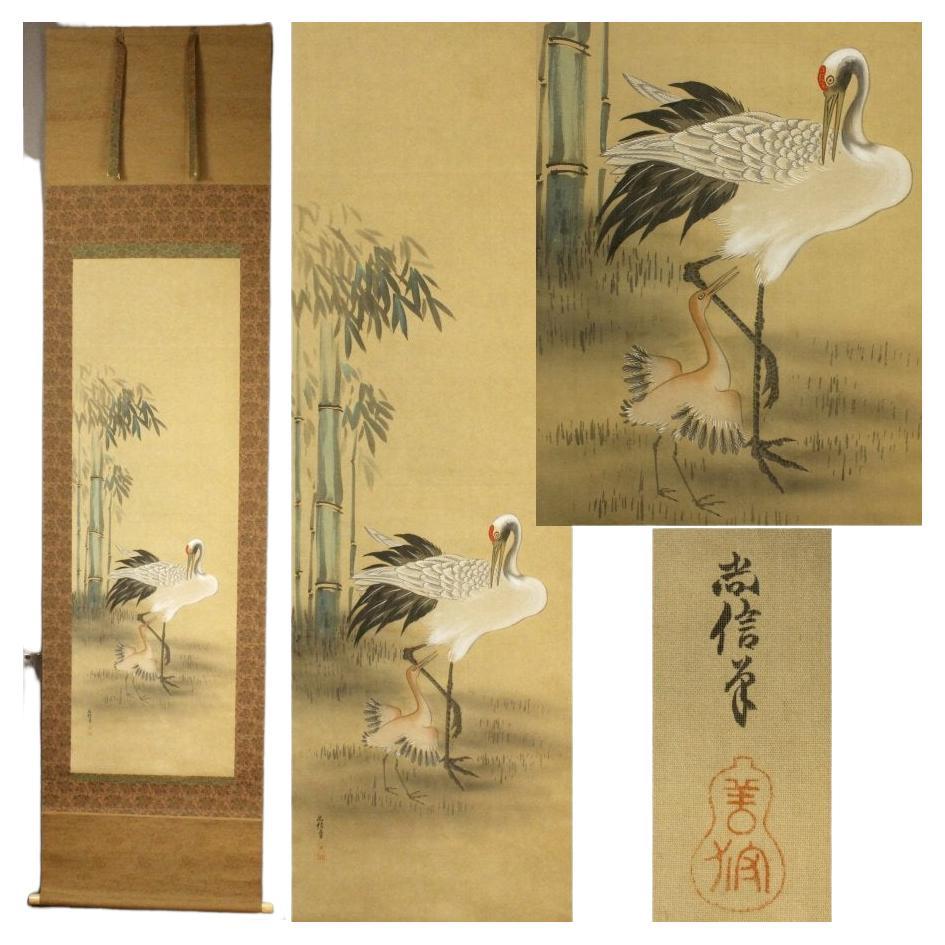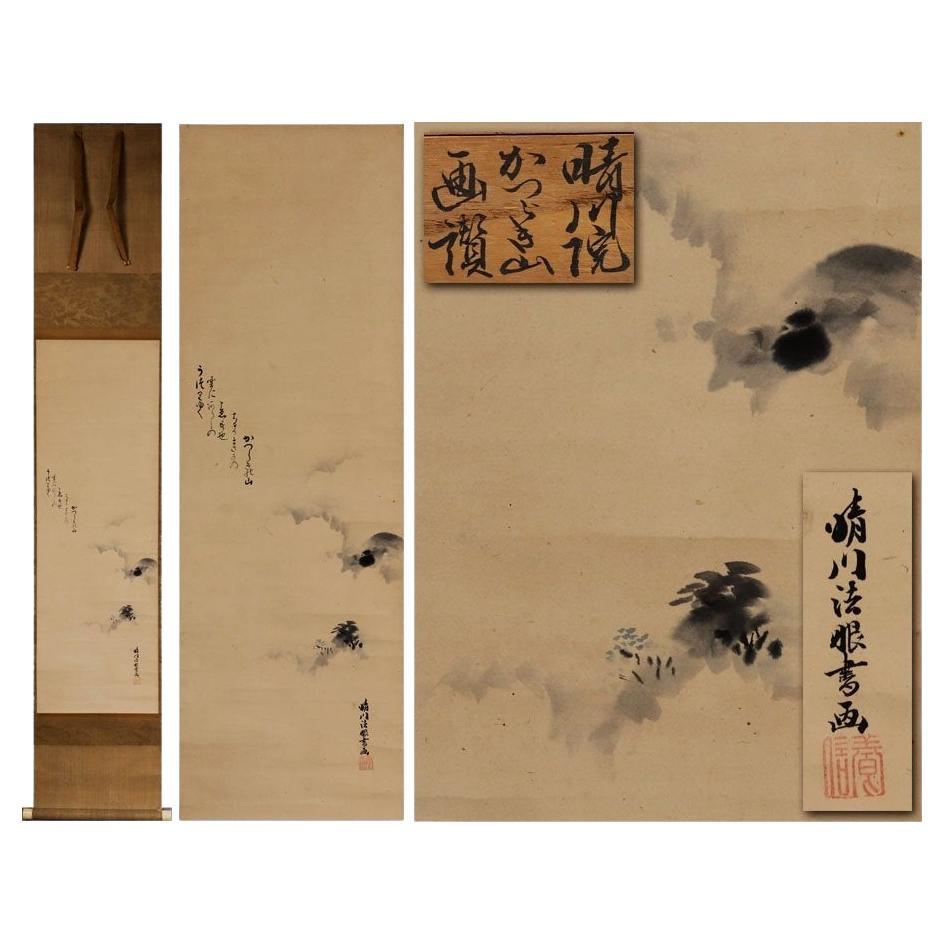Items Similar to Antique Japanese 17th c Edo Scroll Kano Yosanobu Buddhist Painting
Want more images or videos?
Request additional images or videos from the seller
1 of 7
Antique Japanese 17th c Edo Scroll Kano Yosanobu Buddhist Painting
About the Item
Eishin Kano's Ebisu/Great Country Map, double-width/comes with an old box.
The auspicious statues of Ebisu and Daikoku are standing in a double-width hanging scroll with a smiling face,
a figure that seems to ease the stiffness of the hearts of those who see it. In addition, the cover is also very elaborately constructed.
Kanō Yasunobu (狩野 安信, 10 January 1614 – 1 October 1685) was a Japanese painter of the Kanō school of painting during the Edo period. He was the third son of Kanō Takanobu, who had been head of the school, and succeeded Kanō Sadanobu as head of the Kyoto branch in 1623 until he joined his brothers in . Yasunobu was the youngest brother of Kanō Tan'yū, one of the most prominent painters of the Kanō school. His best remembered work is the Gadō Yōketsu, a Kanō school history and training manual. He also worked under the art names Eishin (永真) and Bokushinsai (牧心斎).
■Silk book, handpainted
■Condition:
There is discoloration due to the age.
■Dimensions
Axis dimensions/approx. 186.0cm x approx. 52.5cm.
Main paper dimensions: approx. 102.0cm x approx. 41.5cm.
■Inscription
There are inscriptions and inscriptions as shown.
■Box
Old box.
- Dimensions:Height: 73.23 in (186 cm)Width: 20.67 in (52.5 cm)Depth: 0.04 in (1 mm)
- Style:Edo (Of the Period)
- Materials and Techniques:
- Period:
- Date of Manufacture:1800
- Condition:Wear consistent with age and use.
- Seller Location:Amsterdam, NL
- Reference Number:
About the Seller
5.0
Gold Seller
These expertly vetted sellers are highly rated and consistently exceed customer expectations.
Established in 2015
1stDibs seller since 2019
158 sales on 1stDibs
Typical response time: 9 hours
- ShippingRetrieving quote...Ships From: Amsterdam, Netherlands
- Return PolicyA return for this item may be initiated within 14 days of delivery.
More From This SellerView All
- Japanese Painting 17th c Edo Scroll Triptyque Kano Chikanobu Buddhist PaintingLocated in Amsterdam, Noord HollandTheItem below was painted approximately 300 years ago by Kano Chikanobu. In the center is a depiction of a deer hermit, on the right is a landscape of a tower that gives a sense of ...Category
Antique 17th Century Edo Paintings
MaterialsSilk
- Antique Japanese 18th c Edo Scroll [Kano Baisho Nihonga Landscape PaintingLocated in Amsterdam, Noord HollandThis is a ``Rising Sun and Pine Tree'' drawn by Kano Baisho. It is an item with a solemn taste and presence, and I think it would be a good idea to display it at New Year's, the fir...Category
Antique 18th Century Edo Paintings
MaterialsSilk
- Lovely Japanese Painting 17th c Scroll by Kanō Naonobu Nihonga Cranes JapanLocated in Amsterdam, Noord HollandLovely painting by Naonobu Kano, one of the great masters of the Kano school.It depicts a smiling parent and child, and is an auspicious design, so it would be great to hang it durin...Category
Antique 17th Century Paintings
MaterialsSilk
- Lovely Japanese 18/19th c Edo Scroll Kano Osanobu Nihonga Painting MountainLocated in Amsterdam, Noord HollandKano Osanobu (狩野養信) Osanobu Kano (born August 18, 1796; died June 12, 1846) was the ninth painter of the Kobikicho Kano School in the Edo period. His common name was Shozaburo. His ...Category
Antique 18th Century Edo Paintings
MaterialsSilk
- Antique Japanese 18th c Edo Scroll Rosetsu Nagasawa Nihonga Landscape PaintingLocated in Amsterdam, Noord HollandThe following is a work of art depicting the ``Horai Landscape,'' a land of peach, created by the master artist [Rosetsu Nagasawa] A painter from the late Edo period. There are conf...Category
Antique 18th Century Edo Paintings
MaterialsSilk
- Lovely Japanese 18th c Edo Scroll by Yoshinobu Kano (1747-1797), chrysanthemumLocated in Amsterdam, Noord HollandYoshinobu Kano (1747-1797) A Kano school painter who was active in the early Edo period. Kano Yoshinobu was one of the top Kano School painters of his day. He was the son of Kano Gen...Category
Antique 18th Century Paintings
MaterialsSilk
You May Also Like
- 17th Century Japanese Framed Painting by Kano Sansetsu, Plum Blossoms in SnowLocated in Kyoto, JPKano Sansetsu (1589-1651) Plum blossoms in snow Edo period, circa 1640 Framed painting. Ink on paper. Kano Sansetsu is a Japanese painter who...Category
Antique 17th Century Japanese Edo Paintings and Screens
MaterialsPaper
- 17th Century Japanese Screen. Ink Plum Tree & Birds by Kano Naonobu.Located in Kyoto, JPKano Naonobu (1607-1650) Plum Tree and Birds Six-fold Japanese Screen. Ink and slight color on paper. In this evocative ink work spread over a six-panel folding screen, we see the consummation of the elegance and refinement of the Edo Kano school. This 17th century screen is a rare surviving example of a large-scale bird and flower painting by Kano Naonobu, the younger brother of Kano Tanyu...Category
Antique 17th Century Japanese Edo Paintings and Screens
MaterialsWood, Paper
- 17th Century Japanese Framed Panel by Kano Sansetsu, White Herons in SnowLocated in Kyoto, JPKano Sansetsu (1589-1651) White herons in snow Edo period, circa 1640 Framed painting. Ink on paper. Kano Sansetsu is a Japanese painter who ...Category
Antique 17th Century Japanese Edo Paintings and Screens
MaterialsPaper
- 19th Century Japanese Edo Six Panel Kano School Landscape ScreenLocated in Rio Vista, CALate Edo period 19th century Japanese six-panel landscape screen featuring a cypress tree over a flowering hibiscus with a pair of hototogisu birds. Kano school painted with ink and ...Category
Antique 19th Century Japanese Edo Paintings and Screens
MaterialsSilk, Wood, Paper
- Antique hanging scroll of Japanese cat/Late Edo-Meiji period/Cat paintingLocated in Sammu-shi, ChibaThis is a picture of a cat drawn by a person named "Toshizumi Nitta" from the end of the Edo period to the beginning of the Meiji period. She is a very simple and cute cat. He is a vassal of the Tokugawa Shogunate, born in Ota City, Gunma Prefecture (southern part of Gunma Prefecture). He was related to the Tokugawa family and lived in a large mansion in the Ota clan in Gunma prefecture. However, the Nitta family's territory was very small, and they were by no means a wealthy vassal. He seems to have lived quite poorly. So he painted cats and sold them to people. The Nitta family continued to draw pictures of this cat for four generations. "Nitta toshizumi" is equivalent to the fourth generation. During the Edo period, sericulture was thriving in the Kanto region. Cats were said to be the gods of silkworms, as they drive away mice, the natural enemies of silkworms. It was the Nitta family who drew such a cat on paper, pasted it in the silkworm chamber, and sold it as a mouse repellent. There were also other monks who painted pictures of cats, but the Nitta family in particular was related to the Tokugawa family, so people believed that paintings of cats had special powers. , a lot of paintings...Category
Antique Late 19th Century Japanese Edo Paintings
MaterialsPaper
- 17th century Japanese Falcon Painting, Mitani Toshuku, Unkoku SchoolBy Mitani ToshukuLocated in Kyoto, JPMitani Toshuku (1577-1654) “Falcon” Wall panel, ink and light color on paper. Upper Seal: Mitani Lower Seal: Toshuku Dimensions: Each 118.5 cm x 51 cm x 2 cm (46.5” x 20” x .75”) Individual falcon paintings by Mitani Toshuku (1577-1654), an early artist of the Unkoku School. Founded by Unkoku Togan (1547–1618), a master of the Momoyama period, the Unkoku school enjoyed long lasting patronage in southern Japan. Togan was a retainer of the Mori family in present day Yamaguchi prefecture. Members of the school considered themselves to be in the artistic lineage of Sesshu Toyo...Category
Antique Early 17th Century Japanese Edo Paintings and Screens
MaterialsPaper





